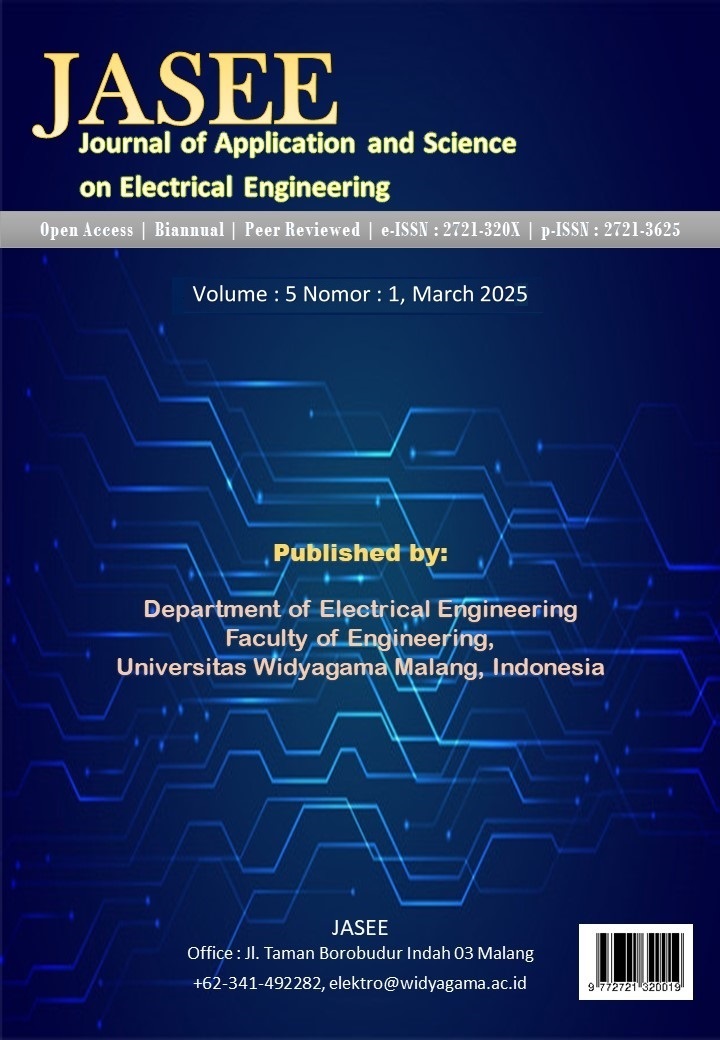Rancang Bangun Smart Office Berbasis Aplikasi Blynk Menggunakan Microcontroler Esp 32
DOI:
https://doi.org/10.31328/jasee.v6i1.6102Keywords:
Blynk, By pass, , ESP 32, Internet of Things, MikrokontrolerAbstract
Internet of things (IOT) is a concept or program where an object has the ability to transmit or send data over a network without the help of computer devices and humans. The development of the internet of things (IOT) is currently taking place rapidly and has been applied in various sectors, including government, business, and industry. By utilizing this technology, management and monitoring of electrical equipment in a building can be done in an integrated manner through internet connectivity. This allows us to prevent excessive use and reduce electricity consumption in rooms that are not being used. The 1st floor building of the engineering faculty has many lights and fans. Not infrequently, negligence often occurs in turning off and on the lights and fans. This study aims to control the lights in the engineering faculty building on the 1st floor using the IOT system through the Blynk application, to provide convenience for people who will control the lights in the engineering faculty building and can be turned off remotely if there is negligence when turning off the lights can be turned off remotely using a smartphone. The results of this study use the ESP 32 type microcontroller and the Blynk application to control the lights and fans. The results can work well. The bypass switch for controlling the lights and fans is used when there is a disruption to the internet network.
References
A. Rahayu, “Sistem Kendali Rumah Pintar Menggunakan Voice Recognition Module V3 Berbasis Mikrokontroler dan IOT,” vol. 6, no. 2, pp. 19–32, 2020.
M. Ali, A. Jatmiko, S. S. Dwiningwarni, and A. N. Afandi, “Peningkatan Keberdayaan Masyarakat Melalui Smart Tourism dan Penguatan Manajemen di Wisata Pandansili,” J. KARINOV, vol. 6, no. 3, p. 185, Sep. 2023, doi: 10.17977/um045v6i3p185-189.
N. Hashim et al., “Smart Farming for Sustainable Rice Production: An Insight into Application, Challenge, and Future Prospect,” 2024. doi: 10.1016/j.rsci.2023.08.004.
E. D. Malia et al., “PERANCANGAN PROTOTYPE SISTEM KUNCI PINTU RUMAH BERBASIS IOT,” vol. 12, no. 2, pp. 1–8, 2021.
A. M. Shiddiqi, R. M. Ijtihadie, T. Ahmad, W. Wibisono, R. Anggoro, and J. Santoso, “Penggunaan Internet dan Teknologi IoT untuk Meningkatkan Kualitas Pendidikan,” vol. 4, no. 3, pp. 235–240, 2020.
I. W. S. Yasa, I. W. D. Pancane, and I. M. Asna, “Tangga Berbasis Aplikasi Telegram,” vol. 1, 2022.
A. Anggrawan, S. Hadi, and C. Satria, “IoT-Based Garbage Container System Using NodeMCU ESP32 Microcontroller,” no. January, 2023, doi: 10.12720/jait.14.4.846-856.
M. Al-mashhadani and M. Shujaa, “IoT Security Using AES Encryption Technology based ESP32 Platform,” vol. 19, no. 2, pp. 214–223, 2022.
A. Nugroho, “Rancang Bangun Sistem Keamanan Mobil Rental Menggunakan Sensor Sidik Jari Berbasis Arduino Dengan Kendali Aplikasi Telegram,” pp. 1–22, 2021.
P. A. Nugroho, “Kontrol lampu gedung melalui wifi ESP8266 dengan web server lokal,” JEIS, vol. 1, pp. 2774–5775, 2021.
R. Berlianti, J. Teknik, E. Program, S. Teknik, and P. N. Padang, “Perancangan Alat Pengontrolan Beban Listrik Satu Phasa Jarak Jauh Menggunakan Aplikasi Blynk Berbasis Arduino Mega,” vol. 5, no. 1, pp. 17–25, 2020.
Downloads
Published
How to Cite
Issue
Section
License
Copyright (c) 2025 JASEE Journal of Application and Science on Electrical Engineering

This work is licensed under a Creative Commons Attribution-NonCommercial 4.0 International License.






